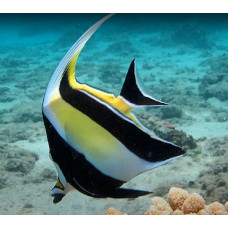Latin name
Zanclus cornutus
Other names
Zanclus cornutus
Identification
The name is derived from the Greek word zagkios - "beveled".
The body is tall, disk-shaped, flattened from the sides. The height of the body can be from 1 to 1.4 lengths. The scales are very fine, each scale has a row of vertical shells, the posterior edge of which is wavy. This gives the surface of the body a roughness like fine-grained sandpaper. The eyes are set high, with protrusions above in adults. The snout is elongated, tube-shaped, with a small mouth at the end; the teeth are numerous, single-row, bristle-shaped, slightly curved backward.
Features of fish fins
The dorsal fin is triangular in shape, with 6-7 (more often 7) barbs and 39-43 soft rays, the third barb being strongly elongated, thread-like. Some sources indicate that the length of the dorsal fin process may exceed the length of the fish's body. The triangular anal fin has 3 barbs and 31-37 soft rays, the pectoral fin has 1 barb and 17-18 soft rays, and the pelvic fin has 1 barb and 5 soft rays. The shape of the unpaired fins gives the body of the fish characteristic semilunar outlines.
Fish colouring
Body coloration - alternating vertical black and white-yellow stripes (disruptive coloration), yellow saddle-shaped spot on top of snout, tip of upper jaw black, lower jaw mostly black. Forked caudal fin black with pale posterior margin.
Distribution
They live in the tropical Indo-Pacific region. Their range extends from East Africa to the Rapa Iti and Ducie Islands, north to southern Japan and Hawaii, and south to Lord Howe Island. The species is not found in the Red Sea and Persian Gulf. In the eastern Pacific, the species is distributed from the southern Gulf of California to Peru. In fact, the range of this species is one of the largest in area among marine fishes.
Habitat
Bentopelagic species. They live in coral reefs at depths from 3 to 180 m, preferring areas with hard seabed.
Size
It is a marine fish up to 23 centimeters long. The common size is 21 cm.
Behavior
They inhabit tidal lagoons, rocky and coral reefs, preferring areas with hard bottoms. Fish are often found in pairs, small groups of 2-3 individuals, or rarely in schools (more typical of juveniles). Adults sometimes form harems of 5-10 individuals.
Food and feeding habits
Feeds on sponges, moss animals, coral polyps, other invertebrates and algae. A slender, elongated snout and curved back teeth help the fish pull invertebrates out of the cracks in the reef. Other types of food found in the stomach of the fish are diverse and are probably caught incidentally while feeding on the main food.
Reproduction
Fish of this species spawn in the evening, rising to the surface in pairs and depositing pelagic eggs. Fecundity up to 50,000 eggs, incubation up to 24-48 h. Care of offspring is absent, the larva leads a planktonic lifestyle. The larval stage is acronurus. The long larval stage is the reason for the wide distribution of this fish. After reaching a length of 7.5 cm, the larvae enter the juvenile stage. The coloration of the juveniles differs from that of the adults. Juveniles of this species also have barbs on the corners of their mouths.
A pair is formed for life, the male being lighter and slimmer than the female, and also having larger growths over the eyes. The male is aggressive towards other males of its species and will fight with Chelmon rostratus fish in captivity.
Fishing
Fishing: subsistence; Aquarium: commercial.
Relationship with a person
Among Muslim fishermen, this fish was considered sacred, so the fisherman would release such a fish with a bow if it was accidentally caught in the net. These fish are believed to bring good luck.
A popular aquarium fish, but rarely survives in aquariums.
| Classification | |
| Phylum | Chordata |
| Class | Actinopterygii |
| Squad | Acanthuriformes |
| Family | Zanclidae |
| Genus | Zanclus |
| Species | Z. cornutus |
| Features | |
| Conservation status | Least Concern |
| Habitat | Pelagic |
| Life span, years | No information |
| Maximum body weight, kg | No information |
| Maximum length, cm | 22 |
| Sailing speed, m/s | No information |
| Threat to people | No information |
| Way of eating | Planktonophage |
Moorish idol
Tags: moorish idol



